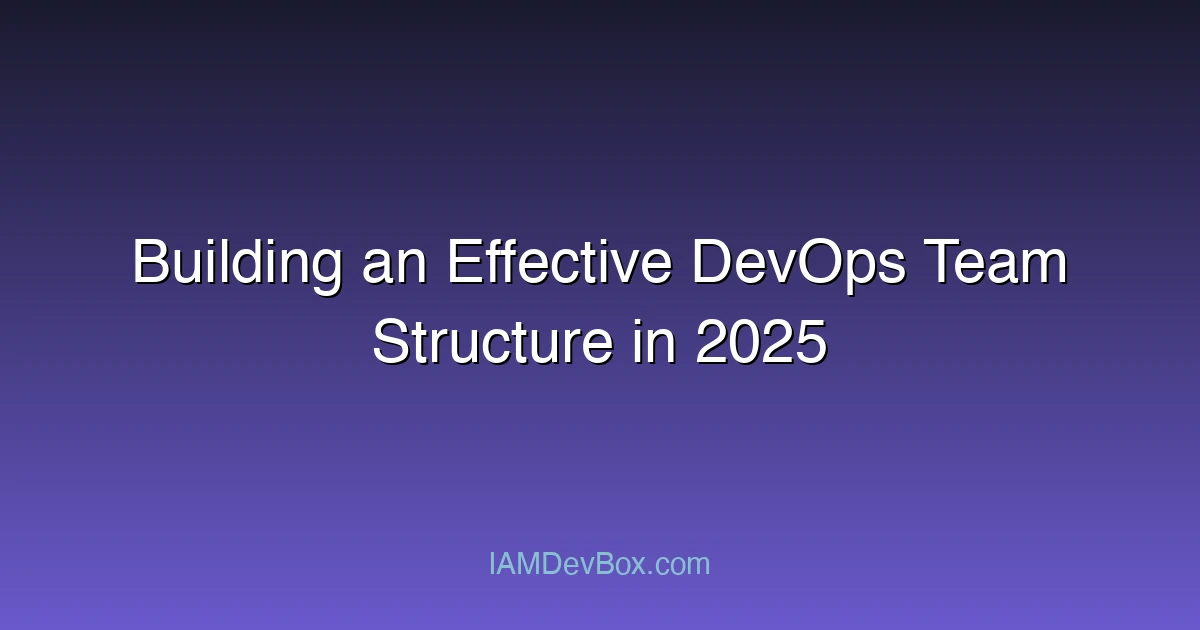In 2025, the demand for efficient and scalable DevOps teams will be higher than ever. Organizations are increasingly adopting cloud-native technologies, CI/CD pipelines, and automation tools to stay competitive. However, without a well-structured DevOps team, these technologies may fail to deliver their full potential.
In this article, we will explore the key principles and best practices for building an effective DevOps team structure in 2025. We will discuss the essential roles, collaboration strategies, and tools that contribute to a successful DevOps team.
Visual Overview:
graph LR
subgraph "CI/CD Pipeline"
Code[Code Commit] --> Build[Build]
Build --> Test[Test]
Test --> Security[Security Scan]
Security --> Deploy[Deploy]
Deploy --> Monitor[Monitor]
end
style Code fill:#667eea,color:#fff
style Security fill:#f44336,color:#fff
style Deploy fill:#4caf50,color:#fff
Key Principles of an Effective DevOps Team Structure
1. Collaboration Over Silos
One of the core principles of DevOps is breaking down silos between development, operations, and other teams. In 2025, cross-functional collaboration will be critical to delivering high-quality software at speed.
Example of Cross-Functional Collaboration:
# Example of a cross-functional team structure
teams:
- name: "Frontend Development"
members:
- frontend_dev1
- frontend_dev2
collaboration:
- with: "Backend Development"
focus: API integration
- with: "DevOps"
focus: Deployment automation
- name: "DevOps"
members:
- devops_engineer1
- devops_engineer2
collaboration:
- with: "QA"
focus: Automated testing
This structure ensures that teams work together towards a common goal, reducing bottlenecks and improving efficiency.
2. Automation as a Foundation
Automation is the backbone of any modern DevOps team. In 2025, teams will rely heavily on tools like Jenkins, GitLab CI/CD, and AWS CodePipeline to automate repetitive tasks.
Example of Automation in CI/CD:
# Example of a CI/CD pipeline configuration
stages:
- build:
script: ./build.sh
- test:
script: ./run_tests.sh
- deploy:
script: ./deploy.sh
only:
- main
This pipeline automates the build, test, and deployment processes, ensuring faster feedback loops and fewer human errors.
3. Monitoring and Feedback Loops
Continuous monitoring and feedback are essential for maintaining high system performance and reliability. Teams in 2025 will use tools like Prometheus, Grafana, and ELK Stack to monitor their systems.
Example of Monitoring Configuration:
# Example of Prometheus monitoring configuration
scrape_configs:
- job_name: "node_exporter"
static_configs:
- targets: ["localhost:9100"]
- job_name: "app_server"
static_configs:
- targets: ["app-server:8080"]
This configuration ensures that critical metrics are tracked and alerts are triggered when thresholds are exceeded.
Essential Roles in a Modern DevOps Team
1. DevOps Engineer
The DevOps Engineer is responsible for designing, implementing, and maintaining the infrastructure and pipelines. They work closely with developers and operations teams to ensure smooth deployments and monitoring.
2. Site Reliability Engineer (SRE)
The SRE focuses on ensuring system reliability and minimizing downtime. They implement best practices for incident management and post-mortem analysis.
3. Cloud Architect
The Cloud Architect designs the cloud infrastructure and ensures optimal resource utilization. They work with the DevOps team to implement scalable and cost-effective solutions.
4. Automation Engineer
The Automation Engineer specializes in creating and maintaining automated workflows. They ensure that repetitive tasks are handled efficiently, reducing manual intervention.
Best Practices for Building an Effective DevOps Team
1. Adopt Infrastructure as Code (IaC)
IaC is a critical practice for modern DevOps teams. Tools like Terraform and AWS CloudFormation allow teams to manage infrastructure programmatically.
Example of Terraform Configuration:
# Example of Terraform configuration for AWS EC2 instance
resource "aws_instance" "example" {
ami = "ami-0c576598ff078ac2c"
instance_type = "t2.micro"
tags = {
Name = "example-instance"
}
}
This configuration ensures consistent and repeatable infrastructure deployments.
2. Implement Continuous Monitoring
Teams should implement continuous monitoring to track system health and performance. Tools like Prometheus and Grafana provide real-time insights into system metrics.
3. Encourage Continuous Learning
The DevOps landscape is constantly evolving, and teams must stay up-to-date with the latest tools and practices. Encourage team members to attend conferences, workshops, and training sessions.
🎯 Key Takeaways
- How do I start restructuring my DevOps team for better efficiency?
- What are the key roles needed in a modern DevOps team?
- How can I ensure continuous improvement in my team's processes?
Conclusion
Building an effective DevOps team structure in 2025 requires a focus on collaboration, automation, and continuous improvement. By adopting the principles and best practices discussed in this article, organizations can create a scalable and efficient DevOps team that delivers high-quality software at speed.
FAQs
- How do I start restructuring my DevOps team for better efficiency?
- What are the key roles needed in a modern DevOps team?
- How can I ensure continuous improvement in my team’s processes?
